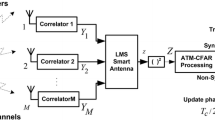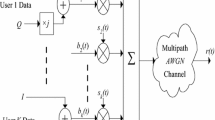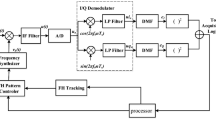Abstract
An adaptive non-coherent smart-antennas double-dwell code acquisition scheme for code division multiple access (CDMA) communication systems is studied and analyzed in this work. A combination of adaptive thresholding based on constant false alarm rate algorithms and smart-antennas technique is considered. One of the most important problems of PN code acquisition for DS/SS-CDMA communication systems is the presence of multipath signals, which have a random structure. Accordingly, an adaptively varying threshold scheme using automatic censoring algorithm based on ordered data variability, namely the automatic censoring adaptive processor (ACAP) is considered to improve the system performance. The drawback of this algorithm is that a large processing time is required if the serial search code acquisition scheme is used. Hence, the double-dwell search-scheme is proposed to solve this problem. The performance of the proposed system is analyzed in frequency-selective Rayleigh fading channels. It is shown through simulation results that, the smart-antennas double-dwell acquisition scheme with the ACAP algorithm significantly outperforms the existing adaptive smart-antenna serial search single-dwell systems.





















Similar content being viewed by others
References
Santi, P., Maity, S. H., & Chinmay, M. (2014). Optimal power allocation in DS-CDMA with adaptive SIC technique. Telecommunication Systems, 56, 335–346.
Dilek, S., & Kucur, O. (2010). Performance of multi-processing gain QS-CDMA over AWGN and Rayleigh fading channels. Digital Signal Processing, 20, 1207–1214.
Steele, R., Lee, C.-C., & Gould, P. (2001). GSM, cdmaOne, and 3G systems. England: Wiley.
Gordon, L. S. (2012). Principle of mobile communication. New York: Springer.
Jamshidi, A. (2011). Direct sequence spread spectrum point-to-point communication scheme in underwater acoustic sparse channels. IET Communications, 5, 456–466.
O’Mahony, N., Colin, C. M., & Lachapelle, G. (2011). A dual-threshold up-down counter for GPS acquisition. Signal Processing, 91, 1093–1102.
Polydoros, A., & Weber, C. (1984). A unified approach to serial search spread-spectrum code acquisition–part I: General theory. IEEE Transactions on Communications, 32, 542–549.
Sourour, E. A., & Gupta, S. C. (1990). Direct-sequence spread-spectrum parallel acquisition in a fading mobile channel. IEEE Transactions on Communications, 38, 992–998.
Zhuang, W. (1996). Non coherent hybrid parallel PN code acquisition for CDMA mobile communications. IEEE Transactions on Vehicular Technology, 45, 643–656.
Oh, H. S., & Han, D. S. (2005). An adaptive double-dwell PN code acquisition system in DS-CDMA communications. Signal Processing, 85, 2327–2337.
Krouma, H., Barkat, M., Kemih, K., Benslama, M., & Yacine, Y. (2008). Performance analysis of an adaptive threshold hybrid double-dwell system with antenna diversity for acquisition in DS-CDMA systems. International Journal of Information and Communication Engineering, 4, 376–385.
Yang, H.-L., & Wu, W.-R. (2008). A low-complexity adaptive antenna array code acquisition. Signal Processing, 88, 1191–1202.
Vali, R., Berber, S. M., & Nguang, S. K. (2010). Effect of Rayleigh fading on non-coherent sequence synchronization for multi-user chaos based DS-CDMA. Signal Processing, 90, 1924–1939.
Oh, H. S., Lim, C. H., & Han, D. S. (2002). Adaptive hybrid PN acquisition with antenna diversity in DS-CDMA systems. IEICE Transactions on Communications E, 85B, 716–722.
Godara, L. C. (2004). Smart antennas (1st ed.). New York: CRC Press LLC.
Berbra, K., Barkat, M., & Anou, A. (2014). PN code acquisition using smart antenna and adaptive thresholding CFAR based on ordered data variability for CDMA communications. Progress Electromagnetics Research B, 57, 139–155.
Aissaoui, A., Hammoudi, Z., & Farrouki, A. (2008). Adaptive pseudo-noise code acquisition scheme using automatic censoring for DS/SS communication in frequency-selective Rayleigh fading channel. IET Communications, 2, 359–365.
Kwon, H., Song, I., Kim, S. Y., & Yoon, S. (2007). Noncoherent constant false-alarm rate schemes with receive diversity for code acquisition under homogeneous and nonhomogeneous fading circumstances. IEEE Transactions on Vehicular Technology, 56, 2108–2120.
El Mashade, M.-B. (2011). Analysis of adaptive detection of moderately fluctuating radar targets in target multiplicity environments. Journal of the Franklin Institute, 348, 941–972.
Kim, C. J., Lee, H. J., & Lee, H. S. (1998). Adaptive acquisition of PN sequences for DSSS communications. IEEE Transactions on Communications, 46, 993–996.
Hacini, L., Farrouki, A., & Hammoudi, Z. (2012). Adaptive hybrid acquisition of PN sequences based on automatic multipath cancellation in frequency-selective Rayleigh fading channels. Wireless Personal Communications, 63, 147–166.
Wang, B., & Kwon, H. M. (2003). PN code acquisition using smart antenna for spread-spectrum wireless communications—Part I. IEEE Transactions on Vehicular Technology, 52, 142–149.
Alamri, T. H., Alshebeili, S. A., & Barkat, M. (2007). Serial acquisition of SD-CDMA signals using smart antennas and adaptive thresholding constant false alarm rate processing. In Proceeding of IEEE international conference on signal processing and communications, ICSPC, pp. 24–27.
Alhariqi, N., Barkat, M., & Sofwan, A. (2012). Serial PN acquisition using smart antenna and censored mean level CFAR adaptive thresholding for a DS/CDMA mobile communication. In Proceedings IEEE 14th international conference on high performance computing and communications, HPCC, pp. 1193–1198.
Sofwan, A., & Barkat, M. (2012). PN code acquisition using smart antennas and adaptive thresholding trimmed-mean CFAR processing for CDMA communication. In Proceeding of spring world congress on engineering and technology, SCET.
Sofwan, A., Barkat, M., & AlQahtani, S. A. (2016). PN code acquisition using smart antennas and adaptive thresholding for spread spectrum communications. Wireless Networks, 22(1), 223–234.
Farrouki, A., & Barkat, M. (2005). Automatic censoring CFAR detector based on ordered data variability for nonhomogeneous environments. IEE Proceedings Radar Sonar and Navigation, 152, 43–51.
Wei, S., & Wang, X. (2009). Research of CMLD-CFAR detecting algorithm in Radar reconnaissance receiver. In Proceedings of IEEE international conference on measuring technology and mechatronics automation, ICMTMA, pp. 105–108.
Rohling, H. (1983). Radar CFAR thresholding in clutter and multiple target situations. IEEE Transactions on Aerospace and Electronic Systems, 19, 608–621.
Author information
Authors and Affiliations
Corresponding author
Rights and permissions
About this article
Cite this article
Benkrinah, S., Benslama, M. Adaptive Double-Dwell Code Acquisition Scheme of PN Sequences Using Smart-Antenna and Automatic Censoring Techniques. Wireless Pers Commun 98, 2187–2210 (2018). https://doi.org/10.1007/s11277-017-4969-6
Published:
Issue Date:
DOI: https://doi.org/10.1007/s11277-017-4969-6




